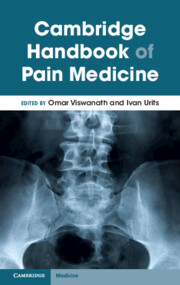Book contents
- Cambridge Handbook of Pain Medicine
- Cambridge Handbook of Pain Medicine
- Copyright page
- Contents
- Contributors
- Pain Handbook Introduction
- Part I Introduction to Pain: Pain Signaling Pathways
- Part II Common Categories of Pharmacologic Medications to Treat Chronic Pain
- Part III Chronic Pain Conditions Head and Neck
- Chapter 11 Post-dural Puncture Headache
- Chapter 12 Migraines
- Chapter 13 Trigeminal Neuralgia
- Chapter 14 Occipital Neuralgia
- Part IV Spine
- Part V Extremities
- Part VI Misc
- Part VII Adjunctive Therapy
- Index
- References
Chapter 14 - Occipital Neuralgia
from Part III - Chronic Pain Conditions Head and Neck
Published online by Cambridge University Press: 01 December 2023
- Cambridge Handbook of Pain Medicine
- Cambridge Handbook of Pain Medicine
- Copyright page
- Contents
- Contributors
- Pain Handbook Introduction
- Part I Introduction to Pain: Pain Signaling Pathways
- Part II Common Categories of Pharmacologic Medications to Treat Chronic Pain
- Part III Chronic Pain Conditions Head and Neck
- Chapter 11 Post-dural Puncture Headache
- Chapter 12 Migraines
- Chapter 13 Trigeminal Neuralgia
- Chapter 14 Occipital Neuralgia
- Part IV Spine
- Part V Extremities
- Part VI Misc
- Part VII Adjunctive Therapy
- Index
- References
Summary
Occipital neuralgia (ON) is a rare headache disorder mainly affecting the posteriorupper neck and posterior head region. By definition, ON is characterized by paroxysmal shooting or stabbing, sudden-onset pain that has frequent recurrence, lasting for a few minutes at a time. This pain syndrome is related to the nerve distribution that involves spinal nerves emerging from the upper cervical region that traverse to the base of the neck and run up the posterior scalp. It involves compression, injury, or trauma to greater occipital nerve (GON), lesser occipital nerve (LON), and then rarely due to third occipital nerve (TON). Conceptually, nerve entrapment between anatomical structures have been hypothesized to be a large contributing factor to the pathophysiology of ON. Most cases of ON are idiopathic with no clear etiology that is structurally identifiable. It is hypothesized that the pain from ON is due to compression, injury, or irritation (e.g. chronic instability, entrapment, trauma, inflammation) of the greater occipital nerve, lesser occipital nerve, and/or the third occipital nerve. Treatment can be conservative or interventional modalities.
- Type
- Chapter
- Information
- Cambridge Handbook of Pain Medicine , pp. 86 - 94Publisher: Cambridge University PressPrint publication year: 2023

